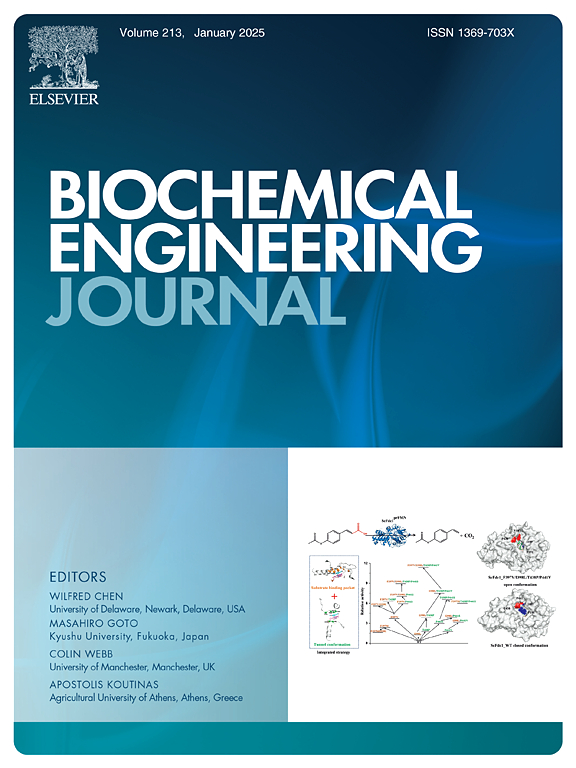Unveiling the antibiotics removal ability of Monoraphidium contortum
IF 3.7
3区 生物学
Q2 BIOTECHNOLOGY & APPLIED MICROBIOLOGY
引用次数: 0
Abstract
This study shows the Monoraphidium contortum potential for removing antibiotics, specifically sulfamethoxazole (SMX) and trimethoprim (TMP), from wastewater. Experiments were conducted using a bench-scale tubular photobioreactor, where the microalga demonstrated the ability to reduce antibiotic concentrations while simultaneously removing inorganic nutrients and producing commercially valuable biomass. When each antibiotic was individually added in the culture medium, M. contortum was able to remove 42.3 % of SMX and 28.6 % of TMP. However, when both antibiotics were introduced simultaneously, SMX removal decreased to 7 %. Additionally, the biochemical composition of the resulting biomass revealed stable lipid content, with a fatty acid profile suitable for biodiesel production. By genome analysis, it was possible to identify a multicopper oxidase enzyme, with potential antibiotic-degrading properties, shedding light on the mechanisms behind the removal process. These findings suggest that M. contortum could play a crucial role in bioremediation and sustainable wastewater treatment, generating feedstock for bioenergy production.
揭示扭曲单胞菌对抗生素的去除能力
该研究显示了单孢霉对废水中抗生素的去除潜力,特别是磺胺甲恶唑(SMX)和甲氧苄啶(TMP)。实验使用一个实验规模的管状光生物反应器进行,其中微藻显示出降低抗生素浓度的能力,同时去除无机营养物质并产生具有商业价值的生物质。当每种抗生素单独添加到培养基中时,弯曲菌能够去除42.3% %的SMX和28.6% %的TMP。然而,当两种抗生素同时使用时,SMX去除率降至7% %。此外,所得生物质的生化成分显示出稳定的脂质含量,其脂肪酸谱适合生产生物柴油。通过基因组分析,有可能鉴定出具有潜在抗生素降解特性的多铜氧化酶,从而揭示了去除过程背后的机制。这些发现表明,M. contortum可能在生物修复和可持续废水处理中发挥关键作用,为生物能源生产提供原料。
本文章由计算机程序翻译,如有差异,请以英文原文为准。
求助全文
约1分钟内获得全文
求助全文
来源期刊

Biochemical Engineering Journal
工程技术-工程:化工
CiteScore
7.10
自引率
5.10%
发文量
380
审稿时长
34 days
期刊介绍:
The Biochemical Engineering Journal aims to promote progress in the crucial chemical engineering aspects of the development of biological processes associated with everything from raw materials preparation to product recovery relevant to industries as diverse as medical/healthcare, industrial biotechnology, and environmental biotechnology.
The Journal welcomes full length original research papers, short communications, and review papers* in the following research fields:
Biocatalysis (enzyme or microbial) and biotransformations, including immobilized biocatalyst preparation and kinetics
Biosensors and Biodevices including biofabrication and novel fuel cell development
Bioseparations including scale-up and protein refolding/renaturation
Environmental Bioengineering including bioconversion, bioremediation, and microbial fuel cells
Bioreactor Systems including characterization, optimization and scale-up
Bioresources and Biorefinery Engineering including biomass conversion, biofuels, bioenergy, and optimization
Industrial Biotechnology including specialty chemicals, platform chemicals and neutraceuticals
Biomaterials and Tissue Engineering including bioartificial organs, cell encapsulation, and controlled release
Cell Culture Engineering (plant, animal or insect cells) including viral vectors, monoclonal antibodies, recombinant proteins, vaccines, and secondary metabolites
Cell Therapies and Stem Cells including pluripotent, mesenchymal and hematopoietic stem cells; immunotherapies; tissue-specific differentiation; and cryopreservation
Metabolic Engineering, Systems and Synthetic Biology including OMICS, bioinformatics, in silico biology, and metabolic flux analysis
Protein Engineering including enzyme engineering and directed evolution.
 求助内容:
求助内容: 应助结果提醒方式:
应助结果提醒方式:


